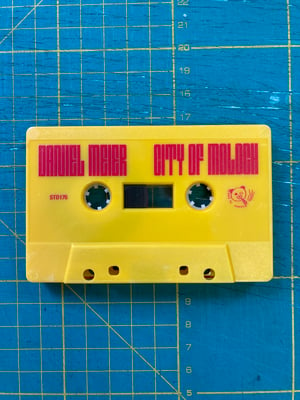Daniel Meier - City of Moloch (2023, MC)
8,00 €

Stream: https://stoned-to-death.bandcamp.com/album/city-of-moloch
The narrative level in music can be naturally manifested visually through the listener's imagination as one of the fundamental experiences of music and a powerful means of communication. This is also the way in which the inner world of the album Cidade Moloch (City of Moloch) gained its visual counterpoint.
The title itself is based on the name of a Gouache painting by Portuguese artist Teresa Câmara Pestana, created in October 2019 upon listening to the first mixes of the album, and I think the sound of the album matches the claustrophobic atmosphere of a place with no peace, no place to rest ears and eyes – a city devouring its inhabitants.
So, this is the shape of landscape, but there is more under the layer of imagination. The main building component of this album is a psychoacoustic phenomenon called combination tones or Tartini tones. When two tones are played at the same time, a third tone can be heard. This third tone is lower than the two tones originally played, and most importantly it is not actually played on the instrument (or sung, in case the two tones are sung), but rather „generated“, sounding outside the instrument. According to recent research there might be even two types of combination tones: those which are generated by the inner ear and “objective combination tones” which can be recorded.
In case of the violin, this third tone is often below the violin´s range. Also, these combination tones have different tone characteristics, they do not sound like a violin, an oboe, the human voice etc. Another very important aspect is intonation. Combination tones require a very precise intonation, in which case the third tone creates a harmonic equivalent to the two tones actually played.
Although combination tones have been discovered not later than early in the 18th century (the violinist and composer Guiseppe Tartini describes how he discovered them by chance in 1714) and also have been discussed quite widely, they have not found much applicable use at least in western classical music. One reason is probably their low audibility. Another reason might be the need to play in natural tuning (just intonation), as opposed to tempered intonation.
From a listener´s perspective, combination tones are often perceived not as tones but as a tone color, a quality of sound. The most prominent example might be the so called „power chords“ used in rock and heavy metal music. In these, it is combination tones which help make the chords sound fuller and heavier. Sometimes combination tones are also perceived as rhythmical beatings, waves, tremolos, and also as something which makes the sound „raspier“ or „rougher“. The perception of combination tones depends mostly on the interval of the two notes that are actually played.
In normal acoustic settings, it is not easy to hear combination tones, as they are not as loud as the tones actually played or sung. One way to make combination tones more audible (at least on the violin and on this album), is by using distortion pedals. However, the distortion effect does not create combination tones in itself, it only helps making them more audible to the listener.
My journey with combination tones and with this album began in spring 2018, when I started experimenting with a looper with built-in distortion effect and a rather low quality guitar amp. The low quality soon turned out to be a real blessing: placing the violin bridge directly on the amp cabinet, the amp rewarded me with low humming feedbacks (which better amps won´t do). These feedbacks can be heard in track 2 and 3 as drones. Improvising over these feedback loops opened a whole new world of texture and color and even of harmony, which turned out to be just the different characteristics of combination tones. The world which at the end manifested as Cidade Moloch.
If you are interested to read more about combination tones, here are some useful links in English, German and Czech:
Conference paper: Combination tones in violins
https://www.researchgate.net/publication/265296863
Szabolcs Horvát: Combination tones: Demonstrating the nonlinearity of the human ear
http://szhorvat.net/pelican/combination-tones.html
with sound examples
New discovery: really good violins make hidden, subtle sounds, Cosmos
https://cosmosmagazine.com/science/combination-tones-violins/
Study linked in this article: Characteristics, mechanisms, and perceivability of combination tones in violins, Journal of the Acoustical Society of America
https://doi.org/10.1121/10.0014600
Angela Lohri: Kombinationstöne und Tartinis »terzo suono«
https://schott-campus.com/kombinationstoene-und-tartinis-terzo-suono/
Martin Hrnčíř: Tartiniho tón: hluboký zvuk, který existuje jen v naší hlavě, fascinuje hudebníky už od baroka, irozhlas.cz
http://irozhl.as/8wp

